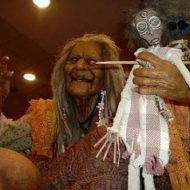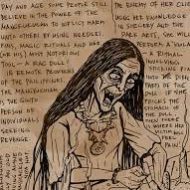Mangkukulam : The Philippine Witch
At a glance
| Description | |
|---|---|
| Origin | Philippine Mythology |
| Classification | Mortals |
| Family Members | N/A |
| Region | Philippines |
| Associated With | Witchcraft, Sorcery, Voodoo |
Mangkukulam
Introduction
The term “Mangkukulam” holds a deep and enduring significance within the cultural tapestry of the Philippines. It is a reference to those who engage in “kulam,” a form of witchcraft or sorcery. This article aims to explore the fascinating realm of the Mangkukulam, their rituals, and their integral role in Philippine folklore. The concept of the Mangkukulam predates the era of Spanish colonization, as witchcraft had already established a firm presence across the Philippine archipelago. In contemporary times, these practices are notably concentrated in regions such as Siquijor, Cebu, Davao, Talalora, Western Samar, and Sorsogon.
Physical Traits
Mangkukulam are reputed for their mastery of spellcasting, the ability to cast curses, and their proficiency in various mystical arts. They are often characterized as individuals who harness their supernatural gifts for both benevolent and malevolent purposes, depending on their intentions and the needs of those who seek their services. Within Filipino society, these practitioners occupy a complex position, simultaneously evoking fear and fascination for their extraordinary abilities.
Throughout the annals of history, Mangkukulam have been subjected to persecution and discrimination, largely stemming from the stigma associated with their craft. The Catholic Church and colonial authorities regarded them as a potential threat to the ascendancy of Christianity and made concerted efforts to suppress their practices. Consequently, many Mangkukulam were compelled to operate covertly, concealing their remarkable talents from the prying eyes of the public.
Family
The interpretation of the term “Mangkukulam” varies across different ethnic groups in the Philippines. For example, in Tagalog, a “Mangkukulam” is essentially someone who practices “kulam.” Conversely, various other ethnic groups employ distinct terms to refer to witches and black magic practices.
Remarkably, despite the Christianization of the Philippines by Spanish colonizers, belief in mystical creatures and practices akin to those of the Mangkukulam persists, particularly in rural regions. This enduring belief system coexists harmoniously with Christianity, illustrating the resilience and cultural diversity inherent in indigenous Filipino traditions.
Other names
The term “Mangkukulam” derives from the Tagalog word “kulam,” which means witchcraft or sorcery. Mangkukulam, therefore, can be loosely translated as “practitioner of witchcraft” or “sorcerer.” The roots of this mystical practice are deeply intertwined with the Philippines’ pre-colonial history and the blending of indigenous beliefs with foreign influences.
Powers and Abilities
The practices of the Mangkukulam can bring about a range of effects on their targets, including ailments that modern medicine struggles to cure, emotional or mental distress for loved ones, diminished mental acuity, sleep disturbances, loss of appetite, unexpected accidents, and various inexplicable occurrences. The Mangkukulam are widely believed to possess covert powers capable of inflicting harm.
Their methods often involve the use of malevolent sympathetic magic, which is occasionally rationalized as a form of punitive action. Typically, their victims are individuals considered “wrongdoers,” such as thieves or those involved in adulterous relationships. However, there also exist practitioners known as “true” sorcerers who do not base their actions on considerations of justice.
A common technique employed by Mangkukulam entails the creation of effigies or poppets, which are connected to the victim through personal items like hair or nail clippings. These effigies are activated through incantations, spells, or symbolic rituals. Additionally, in certain instances, Mangkukulam may engage in rituals that require offerings or sacrifices, often designed to appease spirits or entities from the supernatural realm, with the aim of securing their favor or assistance.
Modern Day Influence
Before the Spanish colonizers set foot in the Philippines during the 16th century, the archipelago was home to a diverse array of indigenous groups, each nurturing their distinct spiritual and magical traditions. These ancient practices encompassed rituals for healing, safeguarding, and divination, deeply interwoven with the fabric of their societies. However, with the advent of Catholicism, a transformation occurred that cast a shadow over these indigenous practices. They were stigmatized, suppressed, and pushed into the clandestine realm, eventually evolving into what we now identify as the Mangkukulam.
The Mangkukulam serves as an enthralling facet of Philippine folklore, granting us access to a rich spectrum of beliefs that constitute the bedrock of the nation’s cultural heritage. Despite the ever-present forces of modernization and societal transformation, the narratives and customs associated with the Mangkukulam persist, underscoring the enduring influence of folklore in shaping collective identities.
While the shroud of stigma and secrecy envelops their craft, the contemporary Mangkukulam continues to adapt and metamorphose, ensuring the longevity of this mystical tradition within the intricate mosaic of Filipino folklore and belief systems. Whether perceived as mystics or witches, the enigmatic allure of the Mangkukulam persists, beckoning those who are drawn to plumb the depths of the supernatural in the Philippines.
Related Images
Frequently Asked Questions
What is lorem Ipsum?
I am text block. Click edit button to change this text. Lorem ipsum dolor sit amet, consectetur adipiscing elit. Ut elit tellus, luctus nec ullamcorper mattis, pulvinar dapibus leo.
What is lorem Ipsum?
I am text block. Click edit button to change this text. Lorem ipsum dolor sit amet, consectetur adipiscing elit. Ut elit tellus, luctus nec ullamcorper mattis, pulvinar dapibus leo.
What is lorem Ipsum?
I am text block. Click edit button to change this text. Lorem ipsum dolor sit amet, consectetur adipiscing elit. Ut elit tellus, luctus nec ullamcorper mattis, pulvinar dapibus leo.
What is lorem Ipsum?
I am text block. Click edit button to change this text. Lorem ipsum dolor sit amet, consectetur adipiscing elit. Ut elit tellus, luctus nec ullamcorper mattis, pulvinar dapibus leo.
What is lorem Ipsum?
I am text block. Click edit button to change this text. Lorem ipsum dolor sit amet, consectetur adipiscing elit. Ut elit tellus, luctus nec ullamcorper mattis, pulvinar dapibus leo.











